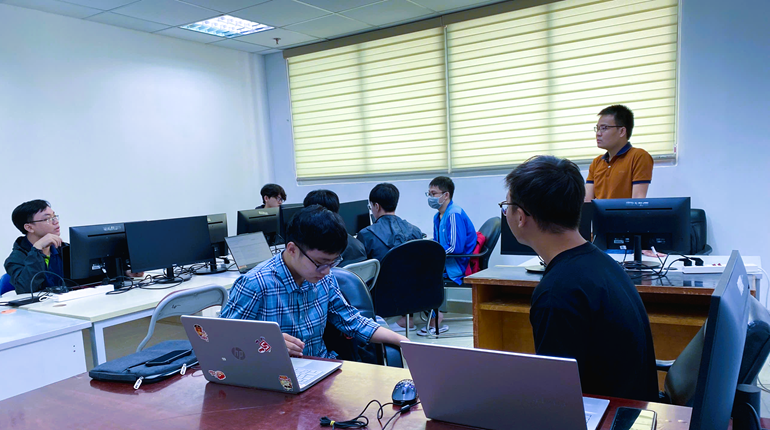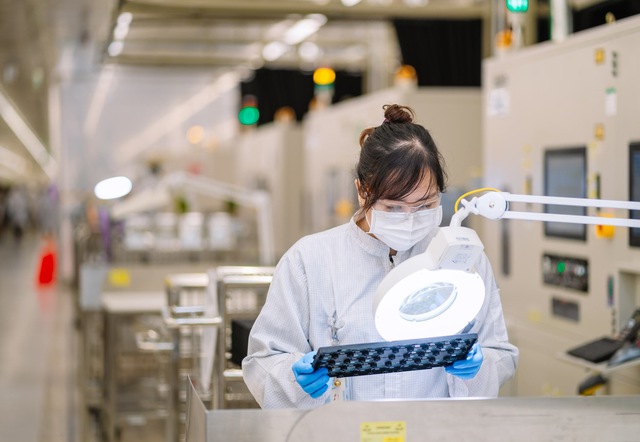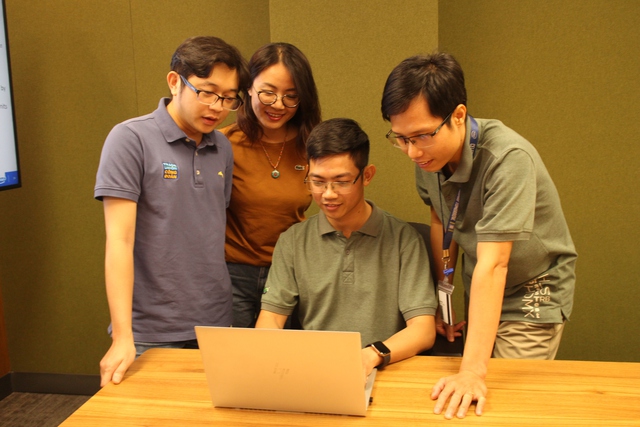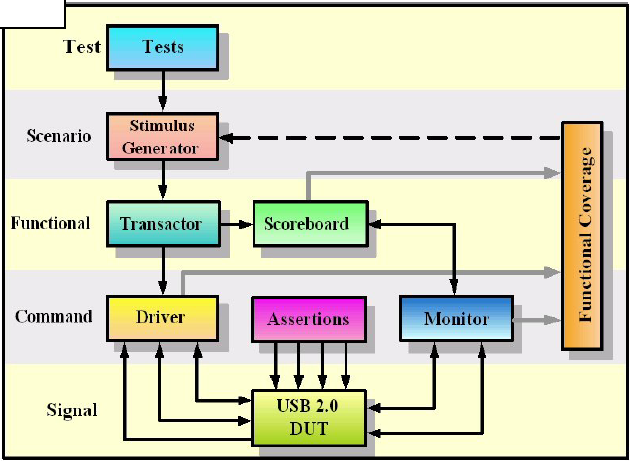
Bài viết này giới thiệu cách làm thế nào để truy xuất GPIO bằng C++ trên kit RPI . Có 2 cách để thực hiện điều này :
- Cách thứ nhất là tác động trực tiếp tới các thanh ghi GPIO trên RPI giống như phương pháp lập trình vi điều khiển thông thường mà không có hệ điều hành (OS) . Ưu điểm của phương pháp này là hoàn toàn bỏ qua hệ điều hành, các chân GPIO sẽ được truy xuất rất nhanh. Tuy nhiên cách này không an toàn và có thể gây ra xung đột bởi sự truy xuất cùng lúc của nhiều quá trình đến các thanh ghi vật lý trên RPI.
- Cách thứ hai : Sử dụng cách truy xuất GPIO an toàn thông qua driver đã được xây dựng sẵn trên Linux OS. Về cơ bản nó xem mỗi thuộc tính của mỗi chân GPIO như là 1 tập tin. Công việc của ta là thao tác với các tập tin này để điều khiển GPIO. Đây là phương pháp được ưu tiên để truy xuất GPIO .
Bài viết này sẽ trình bày theo cách thứ hai. Mô hình kết nối như sau :

Mục đích của lớp GPIOClass là cho phép điều khiển từng chân GPIO. Lớp này được thiết kế sao cho GPIO pin number được xác định thông qua hàm khởi tạo của lớp GPIOClass. file header “GPIOClass.h” được cung cấp bên dưới :
#ifndef GPIO_CLASS_H #define GPIO_CLASS_H #include <string> using namespace std; class GPIOClass { public: GPIOClass(); GPIOClass(string x); int export_gpio(); int unexport_gpio(); int setdir_gpio(string dir); int setval_gpio(string val); int getval_gpio(string& val); string get_gpionum();private: string gpionum;}; #endifMỗi object GPIOClass có các hàm thành viên cho phép ta export hoặc unexport GPIO pins, set direction của GPIO pins cũng như get value của GPIO pins. object GPIOClass có 1 biến private để lưu chỉ số GPIO pin.
Dưới đây là nội dung file “GPIOClass.cpp” :
#include <fstream> #include <string> #include <iostream> #include <sstream> #include "GPIOClass.h" using namespace std; GPIOClass::GPIOClass() { this->gpionum = "4";} GPIOClass::GPIOClass(string gnum) { this->gpionum = gnum; } int GPIOClass::export_gpio() { string export_str = "/sys/class/gpio/export"; ofstream exportgpio(export_str.c_str()); if (exportgpio < 0){ cout << " OPERATION FAILED: Unable to export GPIO"<< this->gpionum <<" ."<< endl; return -1; } exportgpio << this->gpionum ; exportgpio.close(); return 0; } int GPIOClass::unexport_gpio() { string unexport_str = "/sys/class/gpio/unexport"; ofstream unexportgpio(unexport_str.c_str()); if (unexportgpio < 0){ cout << " OPERATION FAILED: Unable to unexport GPIO"<< this->gpionum <<" ."<< endl; return -1; } unexportgpio << this->gpionum ; unexportgpio.close(); return 0; } int GPIOClass::setdir_gpio(string dir) { string setdir_str ="/sys/class/gpio/gpio" + this->gpionum + "/direction"; ofstream setdirgpio(setdir_str.c_str()); if (setdirgpio < 0){ cout << " OPERATION FAILED: Unable to set direction of GPIO"<< this->gpionum <<" ."<< endl; return -1; } setdirgpio << dir; setdirgpio.close(); return 0; } int GPIOClass::setval_gpio(string val) { string setval_str = "/sys/class/gpio/gpio" + this->gpionum + "/value"; ofstream setvalgpio(setval_str.c_str()); if (setvalgpio < 0){ cout << " OPERATION FAILED: Unable to set the value of GPIO"<< this->gpionum <<" ."<< endl; return -1; } setvalgpio << val setvalgpio.close() return 0; } int GPIOClass::getval_gpio(string& val){ string getval_str = "/sys/class/gpio/gpio" + this->gpionum + "/value"; ifstream getvalgpio(getval_str.c_str()) if (getvalgpio < 0){ cout << " OPERATION FAILED: Unable to get value of GPIO"<< this->gpionum <<" ."<< endl; return -1; } getvalgpio >> val ; if(val != "0") val = "1"; else val = "0"; getvalgpio.close(); return 0; } string GPIOClass::get_gpionum(){ return this->gpionum; }Để open hoặc close file trong C++ ta sử dụng các class ifstream/ofstream (ifstream cho nhập (đọc) từ một file, ofstream cho xuất (ghi) tới một file) và fstream cho nhập/xuất (đọc/ghi) tới một file).
Viết một class để test có tên là “GPIOtest1.cpp” như sau :
#include <iostream> #include <unistd.h> #include <errno.h> #include <stdio.h> #include <stdlib.h> #include "GPIOClass.h" using namespace std; int main (void) { string inputstate; GPIOClass* gpio4 = new GPIOClass("4"); GPIOClass* gpio17 = new GPIOClass("17"); gpio4->export_gpio(); gpio17->export_gpio(); cout << " GPIO pins exported" << endl; gpio17->setdir_gpio("in"); gpio4->setdir_gpio("out"); cout << " Set GPIO pin directions" << endl; while(1) { usleep(500000); gpio17->getval_gpio(inputstate); cout << "Current input pin state is " << inputstate <<endl; if(inputstate == "0") { cout << "input pin state is "Pressed ".n Will check input pin state again in 20ms "<<endl; usleep(20000); cout << "Checking again ....." << endl; gpio17->getval_gpio(inputstate); if(inputstate == "0") { cout << "input pin state is definitely "Pressed". Turning LED ON" <<endl; gpio4->setval_gpio("1"); cout << " Waiting until pin is unpressed....." << endl; while (inputstate == "0"){ gpio17->getval_gpio(inputstate); }; cout << "pin is unpressed" << endl; } else cout << "input pin state is definitely "UnPressed". That was just noise." <<endl; } gpio4->setval_gpio("0"); } cout << "Exiting....." << endl; return 0; }Chương trình GPIOtest1.cpp khá đơn giản. Đầu tiên nó khởi tạo hai đối tượng GPIOClass để truy xuất đến GPIO4 và GPIO17 (gpio4 và gpio17) trên header 26 chân .Chú ý tên object được đặt tượng trưng cho tên gpio nhưng ta vẫn có thể đặt tên khác.
Các chân GPIO sau đó được export, GPIO4 set thành output và GPIO17 set input. Vòng lặp vô hạn sẽ đọc trạng thái đầu vào tại chân GPIO17. Nếu trạng thái của chân này là ’0′ nghia là button có thể đã được nhấn. Trạng thái của chân GPIO17 được kiểm tra lại một lần nữa để chắc chắn rằng điều này là đúng và thực hiện set gpio4 lên mức ’1′ để bật LED. Một vòng lặp khác được thực hiện để kiểm tra rằng nếu GPIO17 vẫn còn đang nhấn thì LED trên GPIO4 vẫn tiếp tục sáng đến khi nào thả nút nhấn trên GPIO17.
Nguồn: http://hethongnhung.com/
Bạn có đam mê ngành thiết kế vi mạch và bạn muốn có mức lương 1000 usd cùng lúc bạn
đang muốn tìm một Trung tâm để học vậy hãy đến với ngành vi mạch tại SEMICON

HotLine: 0972 800 931 Ms Duyên


















